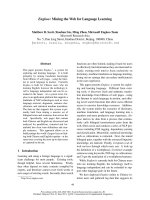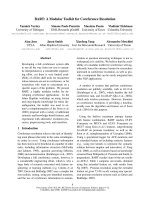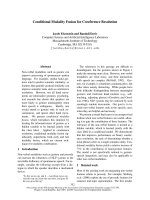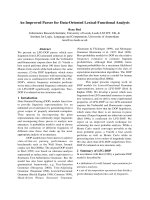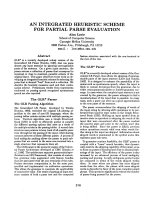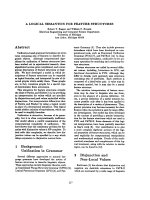Báo cáo khoa học: "An Integrated Platform for Computer-Aided Terminology" pdf
Bạn đang xem bản rút gọn của tài liệu. Xem và tải ngay bản đầy đủ của tài liệu tại đây (730.06 KB, 8 trang )
!
Proceedings of EACL '99
TERM EXTRACTION + TERM CLUSTERING:
An Integrated Platform for Computer-Aided Terminology
Didier
Bourigault
ERSS, UMR 5610 CNRS
Maison de la Recherche
5 all4es Antonio Machado
31058 Toulouse cedex, FRANCE
didier, bourigault @wanadoo. fr
Christian Jacquemin
LIMSI-CNRS
BP 133
91403 ORSAY
FRANCE
j
acquemin@limsi, fr
Abstract
A novel technique for automatic the-
saurus construction is proposed. It is
based on the complementary use of two
tools: (1) a Term Extraction tool that
acquires term candidates from tagged
corpora through a shallow grammar of
noun phrases, and (2) a Term Cluster-
ing tool that groups syntactic variants
(insertions). Experiments performed on
corpora in three technical domains yield
clusters of term candidates with preci-
sion rates between 93% and 98%.
1 Computational Terminology
In the domain of corpus-based terminology two
types of tools are currently developed: tools
for automatic term extraction (Bourigault, 1993;
Justeson and Katz, 1995; Daille, 1996; Brun,
1998) and tools for automatic thesaurus construc-
tion (Grefenstette, 1994). These tools are ex-
pected to be complementary in the sense that
the links and clusters proposed in automatic the-
saurus construction can be exploited for structur-
ing the term candidates produced by the auto-
matic term extractors. In fact, complementarity
is difficult because term extractors provide mainly
multi-word terms, while tools for automatic the-
saurus construction yield clusters of single-word
terms.
On the one hand, term extractors focus on
multi-word terms for ontological motivations:
single-word terms are too polysemous and too
generic and it is therefore necessary to provide
the user with multi-word terms that represent
finer concepts in a domain. The counterpart of
this focus is that automatic term extractors yield
important volumes of data that require structur-
ing through a postprocessor. On the other hand,
tools for automatic thesaurus construction focus
on single-word terms for practical reasons. Since
they cluster terms through statistical measures
of context similarities, these tools exploit recur-
ring situations. Since single-word terms denote
broader concepts than multi-word terms, they ap-
pear more frequently in corpora and are therefore
more appropriate for statistical clustering.
The contribution of this paper is to propose
an integrated platform for computer-aided term
extraction and structuring that results from the
combination of
LEXTER,
a Term Extraction tool
(Bouriganlt et al., 1996), and
FASTR 1,
a Term
Normalization tool (Jacquemin et al., 1997).
2 Components of the Platform for
Computer-Aided Terminology
The platform for computer-aided terminology is
organized as a chain of four modules and the cor-
responding flowchart is given by Figure 1. The
modules are:
POS tagging First the corpus is processed by
Sylex,
a Part-of-Speech tagger. Each word is
unambiguously tagged and receives a single
lemma.
Term Extraction
LEXTER,
the term extrac-
tion tool acquires term candidates from the
tagged corpus. In a first step,
LEXTER
ex-
ploits the part-of-speech categories for ex-
tracting maximal-length noun phrases. It re-
lies on makers of frontiers together with a
shallow grammar of noun phrases. In a sec-
ond step,
LEXTER
recursively decomposes
these maximal-length noun phrases into two
syntactic constituents (Head and Expansion).
Term Clustering The term clustering tool
groups the term candidates produced at the
* FA STR
can be downloaded
www. limsi, fr/Individu/j acquemi/FASTK.
from
15
Proceedings of EACL '99
Raw corpus
P-O-Ssy/exTagging ~ ]
I
L,emmatizcd and tagged corpus
Term
Extraction
LEXTER
I
Network of term candidates
Term Clustering
FASTR
J Expert
[
Interlace
I
Structured ~rminology ~dal~
Figure 1: Overview of the platform for computer-
aided terminology
preceding step through a self-indexing proce-
dure followed by a graph-based classification.
This task is basically performed by FASTR,
a term normalizer, that has been adapted to
the task at hand.
~F-:!etion The last step of thesaurus construc-
tion is the validation of automatically ex-
tracted clusters of term candidates by a ter-
minologist and a domain expert. The vali-
dation is performed through a data-base in-
terface. The links are automatically updated
through the entire base and a structured the-
saurus is progressively constructed.
The following sections provide more details
about the components and evaluate the quality
of the terms thus extracted.
3 Term Extraction
3.1 Term Extraction for the French
Language
Term extraction tools perform statistical or/and
syntactical analysis of text corpora in special-
ized technical or scientific domains. Term can-
didates correspond to sequences of words (most
of the time noun phrases) that are likely to be
terminological units. These candidates are ulti-
mately validated as entries by a terminologist in
charge of building a thesaurus. LEXTER, the
term extractor, is applied to the French language.
Since French is a Romance language, the syntac-
tic structure of terms and compounds is very sim-
ilar to the structure of non-compound and non-
terminological noun phrases. For instance, in
French, terms can contain prepositional phrases
with determiners such as: paroiNoun
deprep /'Det
uret~reNoun (ureteral wall). Because of this simi-
larity, the detection of terms and their variants in
French is more difficult than in the English lan-
guage.
The input of our term extraction tool is an un-
ambiguously tagged corpus. The extraction pro-
cess is composed of two main steps: Splitting and
Parsing.
3.2 Splitting
The techniques of shallow parsing implemented
in the Splitting module detect morpho-syntactical
patterns that cannot be parts of terminological
noun phrases and that are therefore likely to in-
dicate noun phrases boundaries. Splitting tech-
niques are used in other shallow parsers such as
(Grefenstette, 1992). In the case of LEXTER, the
noun phrases which are isolated by splitting are
not intermediary data; they are not used by any
other automatic module in order to index or clas-
sify documents. The extracted noun phrases are
term candidates which are proposed to the user.
In such a situation, splitting must be performed
with high precision.
In order to process correctly some problem-
atic splittings, such as coordinations, attribu-
tive past participles and sequences preposition
+ determiner, the system acquires and uses
corpus-based selection restrictions of adjectives
and nouns (Bourigault et al., 1996).
For example, in order to disambiguate PP-
attachments, the system possesses a corpus-
based list of adjectives which accept a preposi-
tional argument built with the preposition h (at).
These selectional restrictions are acquired through
Corpus-Based Endogenous Learning (CBEL) as
follows: During a first pass, all the adjectives in a
predicative position followed by the preposition h
are collected. During a second pass, each time a
splitting rule has eliminated a sequence beginning
with the preposition el, the preceding adjective is
discarded from the list. Empirical analyses con-
firm the validity of this procedure. More complex
procedures of CBEL are implemented into LEX-
TER in order to acquire nouns sub-categorizing
the preposition h or the preposition sur (on), ad-
jectives sub-categorizing the preposition de (of),
past participles sub-categorizing the preposition
de (of), etc.
Ultimately, the Splitting module produces a set
of text sequences, mostly noun phrases, which we
16
Proceedings of EACL '99
refer to as Maximal-Length Noun Phrases (hence-
forth MLNP).
3.3 Parsing
The Parsing module recursively decomposes the
maximal-length noun phrases into two syntac-
tic constituents: a constituent in head-position
(e.g.
bronchial cell
in the noun phrase
cylindri-
cal bronchial cell,
and
cell
in the noun phrase
bronchial cell),
and a constituent in expansion po-
sition (e.g.
cylindrical
in the noun phrase
cylin-
drical bronchial cell,
and
bronchial
in the noun
phrase
bronchial cell).
The Parsing module ex-
ploits rules in order to extract two subgroups from
each MLNP, one in head-position and the other
one in expansion position. Most of MLNP se-
quences are ambiguous. Two (or more) binary
decompositions compete, corresponding to several
possibilities of prepositional phrase or adjective
attachment. The disambiguation is performed by
a corpus-based method which relies on endoge-
nous learning procedures (Bouriganlt, 1993; Rat-
naparkhi, 1998). An example of such a procedure
is given in Figure 2.
3.4 Network of term candidates
The sub-groups generated by the Parsing module,
together with the maximal-length noun phrases
extracted by the Splitting module, are the term
candidates produced by the Term extraction tool.
This set of term candidates is represented as a
network: each multi-word term candidate is con-
nected to its head constituent and to its expansion
constituent by syntactic decomposition links. An
excerpt of a network of term candidates is given
in Figure 3. Vertical and horizontal links are syn-
tactic decomposition links produced by the Term
Extraction tool. The oblique link is a syntactic
variation link added by the Term Clustering tool.
The building of the network is especially im-
portant for the purpose of term acquisition. The
average number of multi-word term candidates is
8,000 for a 100,000 word corpus. The feedback
of several experiments in which our Term Extrac-
tion tool was used shows that the more structured
the set of term candidates is, the more efficiently
the validation task is performed. For example,
the structuring through syntactic decomposition
allows the system to underscore lists of terms that
share the same term either in head position or in
expansion position. Such paradigmatic series are
frequent in term banks, and initiating the valida-
tion task by analyzing such lists appears to be a
very efficient validation strategy.
This paper proposes a novel technique for en-
riching the network of term candidates through
cell
N 3
"0
bronchial
cell
1
A2N 3
l
[ Expansion link
~ l cylindrical bronchial cell
cylindrical cell
- I
AIN 3
Expansion link
bronchial
A2
I::>-
cyfi~cal
At
1:>
Figure 3: Excerpt of a network of term candidates.
the addition of syntactic variation links to syntac-
tic decomposition links.
4 Term Clustering
4.1 Adapting a Normalization Tool
Term normalization is a procedure used in au-
tomatic indexing for conflating various term oc-
currences into unique canonical forms. More or
less linguistically-oriented techniques are used in
the literature for this task. Basic procedures
such as (Dillon and Gray, 1983) rely on function
word deletion, stemming, and alphabetical word
reordering. For example, the index
library cat-
alogs
is transformed into
catalog librar
through
such simplification techniques.
In the platform presented in this paper, term
normalization is performed by
FASTR,
a shal-
low transformational parser which uses linguistic
knowledge about the possible morpho-syntactic
transformations of canonical terms (Jacquemin et
al., 1997). Through this technique syntactically
and morphologically-related occurrences, such as
stabilisation de prix
(price stabilization) and
sta-
biliser leurs prix
(stabilize their prices), are con-
tinted.
Term variant extraction in
FASTR
differs from
preceding works such as (Evans et al., 1991) be-
cause it relies on a shallow syntactic analysis of
term variations instead of window-based measures
of term overlaps. In (Sparck Jones and Tait, 1984)
a knowledge-intensive technique is proposed for
extracting term variations. This approach has
however never been applied to large scale term ex-
traction because it is based on a full semantic anal-
ysis of sentences. Our approach is more realistic
because it does not involve large-scale knowledge-
intensive interpretation of texts that is known to
be unrealistic.
Our approach to the clustering of term can-
17
Proceedings of EACL '99
Parsing
rule
Noun1 Prep Noun2 Adj -~
Parse
(1)
Head: Noum
Exp.: Nouns Adj
Head: Nouns
Exp.: Adj
Parse
(2)
Head: Noun1 Prep Nouns
Head: Noun1
Exp.: Nouns
Exp.: Adj
Disambiguation procedure:
Look in the corpus for non ambiguous occurrences of the sub-groups:
(a) Noun2 Adj (b) Noun1 Adj (c) Noun1 Prep Noun2
Then choose:
if the sub-group (a) has been found, then choose Parse (1)
else if the sub-groups (b) or (c) have been found, then choose Parse (2)
else choose Parse (1)
Figure 2: An ambiguous parsing rule and associated disambiguation procedure
didates is to group the output of LEXTER, by
conflating term candidates with other term can-
didates instead of confiating corpus occurrences
with controlled terms. Our technique can be seen
as a kind of self-indexing in which term candidates
are indexed by themselves through FASTR, for
the purpose of conflating candidates that are vari-
ants of each other. Thus, the term candidate cel-
lule bronchique cylindrique (cylindrical bronchial
cell) is a variant of the other candidate cellule
cylindrique (cylindrical cell) because an adjecti-
val modifier is inserted in the first term. Through
the self-indexing procedure these two candidates
belong to the same cluster.
4.2 Types of
Syntactic Variation
Rules
Because of this original framework, specific vari-
ations patterns were designed in order to capture
inter-term variations. In this study, we restrict
ourselves to syntactic variations and ignore mor-
phological modifications. The variations patterns
can be classified into the following two families:
Internal insertion of modifiers
The insertion
of one or more modifiers inside a noun phrase
structure. For instance the following trans-
formation NAInsAj:
Noun1 Adj2
+ Noun1 ((Adv ? Adj) 1-3 Adv ?) Adj2
describes the insertion of one to three adjec-
tival modifiers inside a Noun-Adjective struc-
ture in French. Through this transforma-
tion, the term candidate cellule bronchique
cylindrique (cylindrical bronchial cell) is rec-
ognized as a variant of the term candidate
cellule cylindrique (cylindrical cell). Other
internal modifications account for adverbial
and prepositional modifiers.
Preposition switch 8¢ determiner insertion
In French, terms, compounds, and noun
phrases have comparable structures: gen-
erally a head noun followed by adjectival
or prepositional modifiers. Such terms may
vary through lexical changes without signif-
icant structural modifications. For example
NPNSynt:
Noun1 PreI~2 Nouns
4 Noun1 ((Prep Det?) ?) Noun3
accounts for preposition suppressions such
as fibre de collaggne/fibre collaggne (colla-
gen fiber), additions of determiners, and/or
preposition switches such as rev~tement de
surface / rev~tement en surface (surface coat-
ing).
The complete rule set is shown in Table 1. Each
transformation given in the first column conflates
the term structure given in the second column and
the term structure given in the third column.
4.3
Clustering
The output of FASTR is a set of links between
pairs of term candidates in which the target can-
didate is a variant of the source candidate. In
order to facilitate the validation of links by the ex-
pert, this output is converted into clusters of term
candidates. The syntactic variation links can be
considered as the edges of an undirected graph
whose nodes are the term candidates. A node nl
representing a term tl is connected to a node n2
representing t2 if and only if there is a transfor-
mation T such that T(tl) = t2 or T(t2) = tl •
Each connected subgraph Gi of G is considered as
a cluster of term candidates likely to correspond
to similar concepts. (A connected subgraph Gi is
18
Proceedings of EACL '99
Table 1: Syntactic variation rules exploited by the Term Clustering tool.
Ident. Base term Variant
NAInsAv Noun1 Adj2
NAInsAj Noum Adj2
NAInsN Noun1 Adj2
Noun, ((Adv ?
Adj) 0-s
Adv) Adj2
Noun1 ((Adv ? Adj) 1-3 Adv ?) Adje
Noun1 ((Adv ? hdj) ?
(Prep ? Det ? (Adv ? Adj) ? Noun) (Adv ? Adj) ? Adv ?) Adj2
ANInsAv Adjl Noun2
(Adv) Adjl Noun2
NPNSynt
NPNInsAj
NPNInsN
Noun1 Prep2
Noun3
Noun1 Prep2 Noun3
Noun1 Prep2 Noun3
Nounl
((Prep Det?) ?)
Noun3
Noun1 ((Adv ? Adj) °-3 Prep Det ? (Adv ? Adj)0-3 ) Nouns
Noun, ((Adv ? Adj) °-3 (Prep Det?) ? (Adv ? Adj) °-s Noun
(Adv ? Adj) °-3 (Prep Det?) ? (Adv ? Adj)0-3 ) Noun3
NPDNSynt
NPDNInsAj
NPDNInsN
Noun, Prep2 Det4 Nouns
Noun, Prep2 Det4 Noun3
Noun, Prep2 Det4 Noun3
Noun, ((Prep Det?) ?) Nouns
NOunl ((Adv ? Adj) °-3 Prep Det ? (Adv ? Adj)0-3 ) Noun3
Noun1 ((Adv ? Adj) °-3 (Prep Det?) ? (Adv ? Adj) °-3 Noun
(Adv ? Adj) °-3 (Prep Det?) ? (Adv ? Adj)0-3 ) Noun3
nucl~ole souvent pro~minent nucl~ole central pro~minent
t 3e"'~ nsAv NAInsAj.~'~ t2
nucldole pro t~~v
t4
nucldole parfois pro~rainent
Figure 4: A sample 4-term cluster.
such that for every pair of nodes (nl,n2) in Gi,
there exists a path from nl
to n2.)
For example,
tl =nucldole prodminent
(promi-
nent nucleolus),
t2 =nucldole central prodminent
(prominent central nucleolus), t3
=nucldole sou-
vent prodminent
(frequently prominent nucleo-
lus), and t4
=nucl~ole parfois prodminent
(some-
times prominent nucleolus) are four term candi-
dates that build a star-shaped 4-word cluster il-
lustrated by Figure 4. Each edge is labelled with
the syntactic transformation T that maps one of
the nodes to the other.
5
Experiments
Experiments were made on three different corpora
described in Table 2. The first two lines of Table 2
report the size of the corpora and the number
of term candidates extracted by
LEXTER
from
these corpora. The third and fourth lines show
the number of links between term candidates ex-
tracted by
FASTR
and the number of connected
subgraphs corresponding to these links. Finally,
the last two lines report statistics on the size of the
clusters and the ratio of term candidates that be-
Table 3: Frequencies of syntactic variations.
[Menel.] [Brouss.] [DER]
NAInsAv
21% 30% 1%
NAInsAj 33% 25% 5%
NAInsN 23% 21% 13%
ANInsAv 3% 3% 0%
NPNSynt 2% 2% 18%
NPNInsAj 6% 11% 8%
NPNInsN 1% 2% 11%
NPDNSynt
1% 2% 22%
NPDNInsAj 8% 2% 11%
NPDNInsN 2% 2% 11%
Total 100% 100% 100%
long to one of the subgraphs produced by the clus-
tering algorithm. Although the variation rules im-
plemented in the Term Structuring tool are rather
restrictive (only syntactic insertion has been taken
into account), the number of links added to the
network of term candidates is noticeably high. An
average rate of 10% of multi-word term candidates
produced by
LEXTER
belong to one of the clus-
ters resulting from the recognition of term variants
by
FASTR.
Frequencies of syntactic variations are reported
in Table 3. A screen-shot showing the type of
validation that is proposed to the expert is given
by Figure 5.
6 Expert Evaluation
Evaluation was performed by three experts, one in
each domain represented by each corpus. These
experts had already been involved in the con-
19
Proceedings of EACL '99
Table 2: The three corpora exploited in the experiments.
[Broussals] [DER]
[Menelas]
Domain anatomy pathology nuclear engineering coronarian diseases
Type of documents medical reports technical reports medical files
Number of words 40,000
Number of multi-word term 3,439
candidates
Number of variation links 240
Number of clusters 168
Maximal size of the clusters 10
Number of term candidates 438 (12.7%)
belonging to one cluster
230,000 110,000
14,037 10,155
785 634
556 448
13 13
1,349 (9.6%) 1,173 (11.6%)
Figure 5: The expert interface for cluster validation
20
Proceedings of EACL '99
struction of terminological products through the
analysis of the three corpora used in our ex-
periments: an ontology for a case-memory sys-
tem dedicated to the diagnosis support ~n pathol-
ogy ([Broussais]), a semantic dictionary for the
Menelas Natural Language Understanding sys-
tem ([Menelas]), and a structured thesaurus for a
computer-assisted technical writing tool ([DER]).
The precision rates are very satisfactory (from
93% to 98% corresponding to error rates of 7% and
2% given in the last line of Table 4), and show that
the proposed method must be considered as an
important progress in corpus-based terminology.
Only few links are judged as conceptually irrele-
vant by the experts. For example, image d'embole
tumorale (image of a tumorous embolus) is not
considered as a correct variant of image tumorale
(image of a tumor) because the first occurrence
refers to an embolus while the second one refers
to a tumor.
The experts were required to assess the pro-
posed links and, in case of positive reply, they
were required to provide a judgment about the
actual conceptual relation between the connected
terms. Although they performed the validation in-
dependently, the three experts have proposed very
similar types of conceptual relations between term
candidates connected by syntactic variation links.
At a coarse-grained level, they proposed the same
three types of conceptual relations:
Synonymy Both connected terms are consid-
ered as equivalent by the expert: embole
tumorale (tumorous embolus) / embole vascu-
laire tumorale (vascular tumorous embolus).
The preceding example corresponds to a fre-
quent situation of elliptic synonymy: the no-
tion of integrated metonymy (Kleiber, 1989).
In the medical domain, it is a common knowl-
edge that an embole tumorale is an embole
vasculaire tumorale, as everyone knows that
sunflower oil is a synonym of sunflower seed
oil.
Generic/specific relation One of the two
terms denotes a concept that is finer than
the other one: cellule dpithdliale cylindrique
(cylindrical epithelial cell) is a specific type
of cellule cylindrique (cylindrical cell).
Attributive relation As in the preceding case,
there is a non-synonymous semantic relation
between the two terms. One of them denotes
a concept richer than the other one because it
carries an additional attributes: a noyau vo-
lumineux irrdgulier (large irregular nucleus)
is a noyau irrdgulier (irregular nucleus) that
is additionally volumineux (large).
7 Future Work
This study shows that the clustering of term can-
didates through term normalization is a powerful
technique for enriching the network of term can-
didates produced by a Term Extraction tool such
as LEXTER.
In our approach, term normalization is per-
formed through the conflation of specific term
variants. We have focused on syntactic vari-
ants that involve structural modifications (mainly
modifier insertions). As reported in (Jacquemin,
1999), morphological and semantic variations are
two other important families of term variations
which can also be extracted by FASTR. They will
be accounted for in order to enhance the number
of clustered term candidates. It is our purpose to
focus on these two types of variants in the near
future.
Acknowledgement
The authors would like to thank the experts
for their comments and their evaluations of
our results: Pierre Zweigenbaum (AP/HP) on
[Menelas], Christel Le Bozec and Marie-Christine
Janlent (AP/HP) on [Broussais], and Henry
Boccon-Gibod (DER-EDF) on [DER]. We are also
grateful to Henry Boccon-Gibod (DER-EDF) for
his support to this work. This work was partially
funded by l~lectriciti@ de France.
References
Didier Bourigault, Isabelle Gonzalez-Mullier, and
C@cile Gros. 1996. Lexter, a natural language
processing tool for terminology extraction. In
Seventh EURALEX International Congress on
Lexicography (EURALEX96), Part II, pages
771-779.
Didier Bouriganlt. 1993. An endogeneous corpus-
based method for structural noun phrase disam-
biguation. In Proceedings, 6th Conference of the
European Chapter of the Association for Com-
putational Linguistics (EA CL '93), pages 81-86,
Utrecht.
Caroline Brun. 1998. Terminology finite-state
preprocessing for computational lfg. In Proceed-
ings, 36th Annual Meeting of the Association
for Computational Linguistics and 17th Inter-
national Conference on Computational Linguis-
tics (COLING-ACL'98), pages 196-200, Mon-
treal.
21
Proceedings of EACL '99
Table 4: Results of the validation.
[Broussais] [Menelas] [DER]
Number of variation links proposed by the system 240 634 785
Number of variation links validated by the expert 240 227 344
Types of conceptual relation given by the expert
synonymy 44 (18%) 14 (,6%) 136 (40%)
generic/specific 96 (40%) 147 (6.5%) 121 (35%)
attributive 96 (40%) 61 (2'7%) 62 (18%)
non relevant 4 (2%) 5 (2%) 25 (7%)
B6atrice Daille. 1996. Study and implementa-
tion of combined techniques for automatic ex-
traction of terminology. In Judith L. Klavans
and Philip Resnik, editors, The Balancing Act:
Combining Symbolic and Statistical Approaches
to Language, pages 49-66. MIT Press, Cam-
bridge, MA.
Martin Dillon and Ann S. Gray. 1983. FASIT:
A fully automatic syntactically based indexing
system. Journal of the American Society for
Information Science, 34(2):99-108.
David A. Evans, Kimberly Ginther-Webster,
Mary Hart, Robert G. Lefferts, and Ira A.
Monarch. 1991. Automatic indexing using se-
lective NLP and first-order thesauri. In Pro-
ceedings, Intelligent Multimedia Information
Retrieval Systems and Management (RIA 0'91),
pages 624-643, Barcelona.
Gregory Grefenstette. 1992. A knowledge-poor
technique for knowledge extraction from large
corpora. In Proceedings, 15th Annual Inter-
national A CM SIGIR Conference on Research
and Development in Information Retrieval (SI-
GIR '92), Copenhagen.
Gregory Grefenstette. 1994. Explorations in
Automatic Thesaurus Discovery. Kluwer Aca-
demic Publisher, Boston, MA.
Christian Jacquemin, Judith L. Klavans, and Eve-
lyne Tzoukermann. 1997. Expansion of multi-
word terms for indexing and retrieval using
morphology and syntax. In Proceedings, 35th
Annual Meeting of the Association for Compu-
tational Linguistics and 8th Conference of the
European Chapter of the Association for Com-
putational Linguistics (ACL - EACL'97), pages
24-31, Madrid.
Christian Jacquemin. 1999. Syntagmatic and
paradigmatic representations of term varia-
tion. In Proceedings, 37th Annual Meeting of
the Association for Computational Linguistics
(ACL'99), University of Maryland.
John S. Justeson and Slava M. Katz. 1995. Tech-
nical terminology: some linguistic properties
and an algorithm for identification in text. Nat-
ural Language Engineering, 1(1):9-27.
George Kleiber. 1989. Paul est bronzd versus la
peau de paul est bronzde. Contre une approche
r6f~rentielle analytique. In Harro Stammerjo-
harm, editor, Proceedings, Ire colloque interna-
tional de linguistique slavo-romane, pages 109-
134, Tiibingen. Gunter Narr Verlag. Reprinted
in Nominales, A. Colin, Paris, 1995.
Adwait Ratnaparkhi. 1998. Statistical models
for unsupervised prepositional phrase attach-
ment. In Proceedings, 36th Annual Meeting of
the Association for Computational Linguistics
and 17th International Conference on Compu-
tational Linguistics (COLING-ACL'98), pages
1079-1085, Montreal.
Karen Sparck Jones and John I. Tait. 1984. Auto-
matic search term variant generation. Journal
of Documentation, 40(1):50-66.
22

